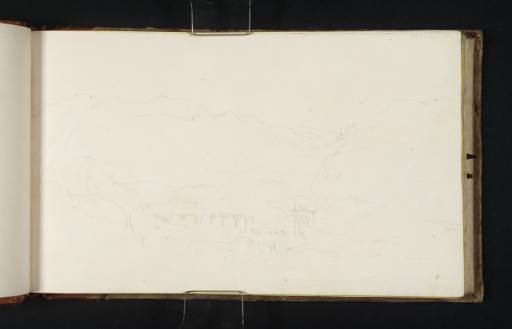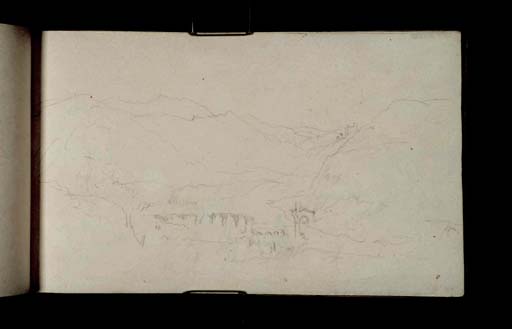Joseph Mallord William Turner Ruined Aqueducts at Ponte degli Arci, near Tivoli 1819
Image 1 of 2
Joseph Mallord William Turner,
Ruined Aqueducts at Ponte degli Arci, near Tivoli
1819
Joseph Mallord William Turner 1775–1851
Folio 85 Verso:
Ruined Aqueducts at Ponte degli Arci, near Tivoli 1819
D15088
Turner Bequest CLXXIX 84 a
Turner Bequest CLXXIX 84 a
Pencil on white wove paper, 112 x 186 mm
Inscribed by the artist in pencil ‘10’ within sketch, near bridge
Inscribed by the artist in pencil ‘10’ within sketch, near bridge
Accepted by the nation as part of the Turner Bequest 1856
References
1909
A.J. Finberg, A Complete Inventory of the Drawings of the Turner Bequest, London 1909, vol.I, p.529 as ‘Aqueduct on the Campagna’.
1996
Gillian Forrester, Turner’s ‘Drawing Book’: The Liber Studiorum, exhibition catalogue, Tate Gallery, London 1996, pp.147 and 148 note 4.
This view depicts the remains of three aqueducts at Ponte degli Arci, on the Via Empolitana in the river valley between Tivoli and Castel Madama. The road runs south and then east, parallel with the River Aniene, until it crosses a tributary known as the Fosso degli Arci. Turner’s sketch shows the approach towards the so-called ‘Arco di Nerone’ (Arch of Nero), actually a surviving arch of the Anio Novus topped by the remnants of a medieval tower, underneath which the road passes.1 The other visible sections of aqueduct are remnants of the Aqua Marcia and Anio Vetus. Further sketches can be seen on folios 84 verso–85 (D15086–D15087; Turner Bequest CLXXIX 83a–84).
Although not one of the most famous pictorial motifs associated with Tivoli, the group of aqueducts had attracted the attention of several artists over the centuries, including Claude Lorrain (circa 1604/5–1682).2 Compare for example, a drawing by Robert Adam (1728–1792), View of the ruins of the Acqua Claudia and the Ponte degli Arci on the way from Tivoli to Subiaco (Sir John Soane’s Museum, London),3 and two paintings by Thomas Cole (1801–1848), A View near Tivoli 1832 (Metropolitan Museum of Art, New York) and The Arch of Nero 1846 (Newark Museum, New Jersey).4 The picturesque properties of the scene had been documented by Revd John Chetwode Eustace in his travel guide, A Classical Tour Through Italy, first published 1813:
As we were winding along the hills, we saw the river meandering beneath us through a beautiful dell, and forming a variety of pleasing scenes, especially near a spot where the ruins of two aqueducts throw their arches over the road, and form a sort of frame for the towers of Tivoli and its neighbouring mountains. An artist who was in company with us took a sketch on the spot, and has since made a very fine drawing of it. The aqueducts frequently re-appeared during the course of the day, sometimes rising like masses of brown rock on the hills, and sometimes sweeping in a succession of lofty arches over the plains. The face of the country was here wooded and there naked, but always bold, and in general very fertile. Its most striking features were a ruined castle on the bank of the river, distant towns lodged in the high recesses of the mountains, particularly St Polo far on the left, and Castel Madama just opposite.5
Turner made notes from these pages in the Italian Guide Book sketchbook (see Tate D13952; Turner Bequest CLXXII 11a).
Nicola Moorby
February 2010
For several images of the aqueduct from the seventeenth to nineteenth centuries including drawings by Claude Lorrain, see Marcel Roethlisberger, ‘Darstellungen einer tiburtinischen Ruine’, Zeitschrift fur Kunstgeschichte, vol.48, 1985, pp.300–18.
See: http://soane.org.uk/drawings/index.cfm?display_scheme=181&object_id=519# , accessed February 2010.
Reproduced in Theodore E. Stebbins, The Lure of Italy: American Artists and the Italian Experience 1760–1914, exhibition catalogue, Museum of Fine Arts, Boston 1992, no.57, pp.286–7.
How to cite
Nicola Moorby, ‘Ruined Aqueducts at Ponte degli Arci, near Tivoli 1819 by Joseph Mallord William Turner’, catalogue entry, February 2010, in David Blayney Brown (ed.), J.M.W. Turner: Sketchbooks, Drawings and Watercolours, Tate Research Publication, December 2012, https://www


